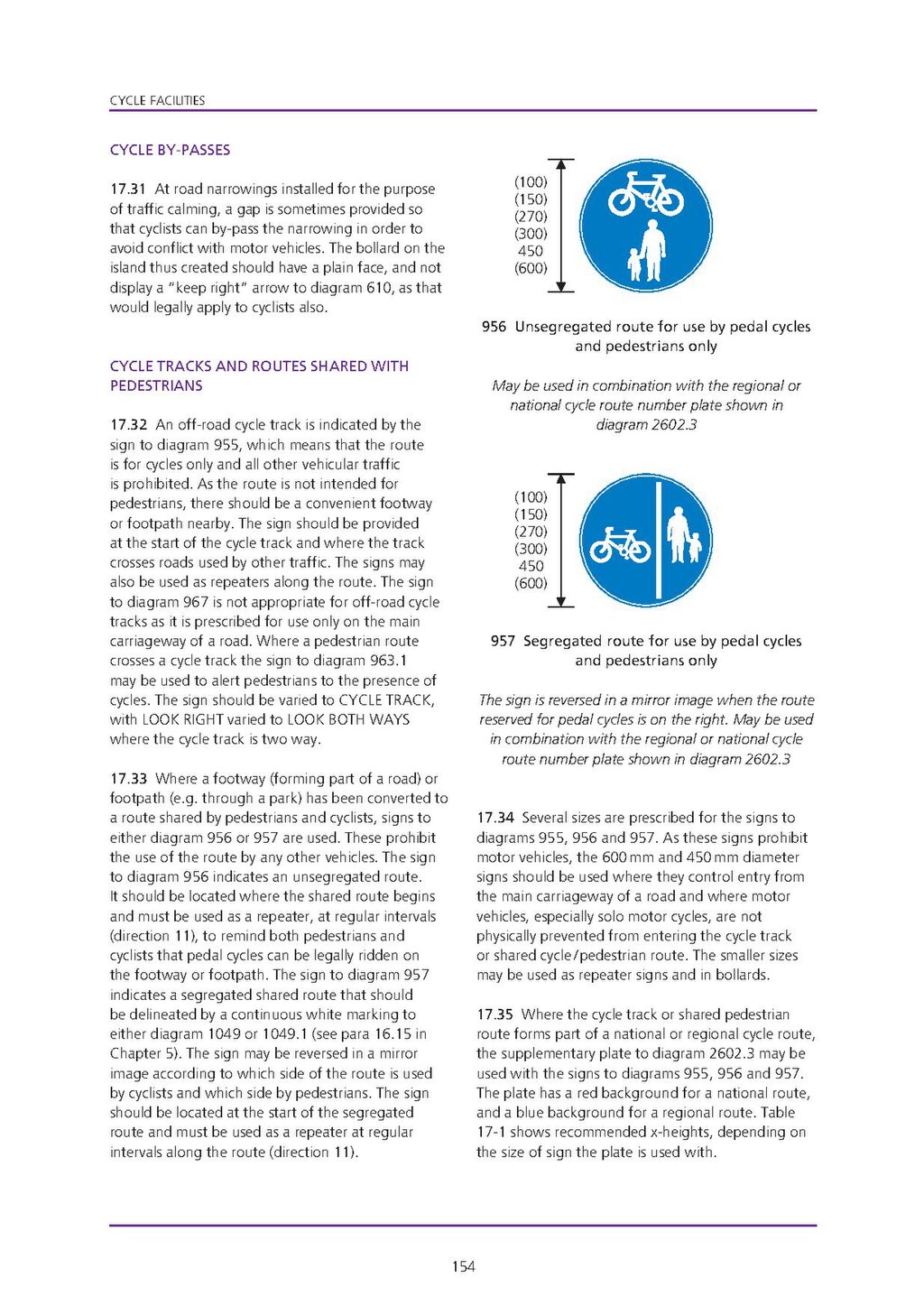CYCLE BY-PASSES
17.31 At road narrowings installed for the purpose of traffic calming, a gap is sometimes provided so that cyclists can by—pass the narrowing in order to avoid conflict with motor vehicles. The bollard on the island thus created should have a plain face, and not display a "keep right" arrow to diagram 610, as that would legally apply to cyclists also.
CYCLE TRACKS AND ROUTES SHARED WITH PEDESTRIANS

956 Unsegregated route for use by pedal cycles and pedestrians only
May be used in combination with the regional or national cycle route number plate shown in diagram 2602.3

957 Segregated route for use by pedal cycles and pedestrians only
The sign is reversed in a mirror image when the route reserved for pedal cycles is on the right. May be used in combination with the regional or national cycle route number plate shown in diagram 2602.3
17.32 An off—road cycle track is indicated by the sign to diagram 955, which means that the route is for cycles only and all other vehicular traffic is prohibited. As the route is not intended for pedestrians, there should be a convenient footway or footpath nearby. The sign should be provided at the start of the cycle track and where the track crosses roads used by other traffic. The signs may also be used as repeaters along the route. The sign to diagram 967 is not appropriate for off—road cycle tracks as it is prescribed for use only on the main carriageway of a road. Where a pedestrian route crosses a cycle track the sign to diagram 963.1 may be used to alert pedestrians to the presence of cycles. The sign should be varied to CYCLE TRACK, with LOOK RIGHT varied to LOOK BOTH WAYS where the cycle track is two way.
17.33 Where a footway (forming part of a road) or footpath (e.g. through a park) has been converted to a route shared by pedestrians and cyclists, signs to either diagram 956 or 957 are used. These prohibit the use of the route by any other vehicles. The sign to diagram 956 indicates an unsegregated route. It should be located where the shared route begins and must be used as a repeater, at regular intervals (direction 11), to remind both pedestrians and cyclists that pedal cycles can be legally ridden on the footway or footpath. The sign to diagram 957 indicates a segregated shared route that should be delineated by a continuous white marking to either diagram 1049 or 1049.1 (see para 16.15 in Chapter 5). The sign may be reversed in a mirror image according to which side of the route is used by cyclists and which side by pedestrians. The sign should be located at the start of the segregated route and must be used as a repeater at regular intervals along the route (direction 11).
17.34 Several sizes are prescribed for the signs to diagrams 955,956 and 957. As these signs prohibit motor vehicles, the 600 mm and 450 mm diameter signs should be used where they control entry from the main carriageway of a road and where motor vehicles, especially solo motor cycles, are not physically prevented from entering the cycle track or shared cycle/pedestrian route. The smaller sizes may be used as repeater signs and in bollards.
17.35 Where the cycle track or shared pedestrian route forms part of a national or regional cycle route, the supplementary plate to diagram 2602.3 may be used with the signs to diagrams 955,956 and 957. The plate has a red background for a national route, and a blue background for a regional route. Table 17-1 shows recommended x—heights, depending on the size of sign the plate is used with.
154
